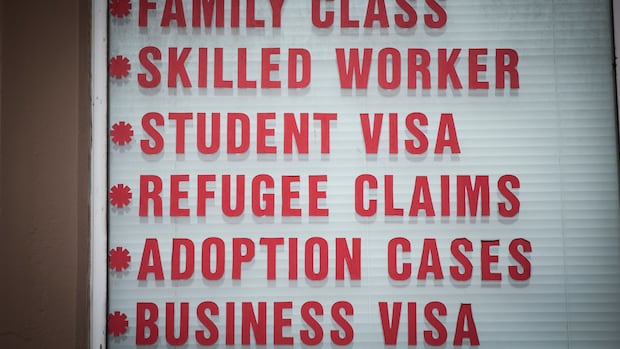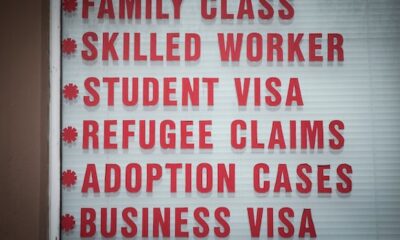Politics
Saskatchewan’s Refugee Claims Surge Nearly 100% Amid Immigration Cuts

The number of refugee claims in Saskatchewan has surged by almost 98%, rising from 683 claims between April and June 2024 to 1,344 during the same period in 2025. This dramatic increase follows significant cuts to both federal and provincial immigration programs, leaving many newcomers in a precarious situation. According to data from Statistics Canada, the number of permanent residents in the province fell by more than half over the same period.
Immigration lawyer Chris Veeman highlighted the plight of individuals who are left with limited options. “I have a consult coming up with someone that’s looking at a refugee claim with no option to continue studying,” he stated. This situation is forcing many to seek asylum as a last resort, particularly as Ottawa has made notable reductions to immigration targets.
Nationally, total asylum claims increased by 32% from the second quarter of 2024 to 2025, climbing from 363,505 to 479,542 claims. The provinces have mirrored Saskatchewan’s trend, with Manitoba experiencing an 87% rise in claims, Alberta seeing a 57% increase, and British Columbia reporting a 53% jump.
Veeman explained that many immigrants are resorting to asylum claims due to a lack of pathways to permanent residency. “If someone files a claim today, they probably won’t get a hearing for about a year and a half,” he noted. This delay can provide individuals the opportunity to work in Canada and support their families back home.
The challenges extend beyond just filing claims. Saskatchewan has recorded the steepest decline in new permanent residents among Canadian provinces, according to Statistics Canada. Between April and June 2025, the province welcomed only 3,467 new permanent residents, down from 7,414 during the same time last year, marking a 53% reduction. Nationally, the total number of new permanent residents fell by 23% during this period.
Ottawa’s latest immigration plan allocates roughly 1,000 additional spots for Saskatchewan’s provincial nominee program, which allows provinces to nominate newcomers based on labor market needs. Yet, this increase may be too little, too late for many who are already on temporary permits. This year, Canada admitted 114,905 people through this program, but the limit for next year has been set at a maximum of 105,000.
Even with the increase, the number of permanent residency spots remains limited compared to the demand. Saskatchewan’s Deputy Minister of Immigration, Drew Wilby, commented, “I think it is very manageable, a very sustainable number,” while acknowledging the need to wait for final numbers from Immigration, Refugees and Citizenship Canada.
The human impact of these statistics is profound. Veeman pointed out the real-life consequences of these policy changes. “It’s wreaking havoc with people’s lives,” he noted, explaining how families have sold homes to support their loved ones in Canada. Many newcomers, like Subbiah S., who moved to Saskatoon in March 2023, are facing unexpected hurdles. “I bought a house as well, considering, ‘OK, next month I’ll be getting my [permanent residency] … but this bomb has dropped,” he shared, reflecting on the emotional toll of the immigration cuts.
Subbiah, an experienced software developer, had hoped his two years of Canadian work experience would facilitate his permanent residency application. However, new rules that took effect this year altered his eligibility. “I came here with a dream of getting PR here and settling down, but unfortunately things got switched up,” he lamented.
The decline in Saskatchewan’s non-permanent residents, which include international students and temporary foreign workers, is also significant. The province saw a net loss of 803 non-permanent residents in the second quarter of 2025, a stark contrast to a net gain of 2,035 in spring 2024.
Stacey Hallman, an analyst with Statistics Canada’s Centre for Demography, noted that federal immigration policies are reshaping migration patterns and population growth rapidly. “In Saskatchewan, the largest drop we see is in the number of immigrants who are permanent residents,” she explained.
Retention of newcomers remains a critical challenge for Saskatchewan. The province experienced a net loss of 1,022 people, primarily moving to Alberta, British Columbia, and Ontario during the spring of 2025. Veeman emphasized the need for more favorable living conditions to retain residents. “People are going to go where they’re going to be happy,” he stated.
In response to these challenges, Saskatchewan’s immigration minister has stated that retention is a key focus. “We’re trying to attach them to the job market, to communities, to make sure they want to stay, build a life, raise families, and continue contributing to Saskatchewan,” he affirmed.
As for Subbiah S., he is now considering relocating to Alberta, where he hopes to qualify for the provincial nominee program through his employer. “We just want to focus upon our future,” he concluded, acknowledging the uncertainty that now surrounds his family’s plans for the future.
-

 Politics6 days ago
Politics6 days agoSecwepemc First Nation Seeks Aboriginal Title Over Kamloops Area
-

 World4 months ago
World4 months agoScientists Unearth Ancient Antarctic Ice to Unlock Climate Secrets
-

 Entertainment4 months ago
Entertainment4 months agoTrump and McCormick to Announce $70 Billion Energy Investments
-

 Lifestyle4 months ago
Lifestyle4 months agoTransLink Launches Food Truck Program to Boost Revenue in Vancouver
-

 Science4 months ago
Science4 months agoFour Astronauts Return to Earth After International Space Station Mission
-

 Technology3 months ago
Technology3 months agoApple Notes Enhances Functionality with Markdown Support in macOS 26
-

 Top Stories1 month ago
Top Stories1 month agoUrgent Update: Fatal Crash on Highway 99 Claims Life of Pitt Meadows Man
-

 Sports4 months ago
Sports4 months agoSearch Underway for Missing Hunter Amid Hokkaido Bear Emergency
-

 Politics3 months ago
Politics3 months agoUkrainian Tennis Star Elina Svitolina Faces Death Threats Online
-

 Politics4 months ago
Politics4 months agoCarney Engages First Nations Leaders at Development Law Summit
-

 Technology4 months ago
Technology4 months agoFrosthaven Launches Early Access on July 31, 2025
-

 Top Stories3 weeks ago
Top Stories3 weeks agoFamily Remembers Beverley Rowbotham 25 Years After Murder




















